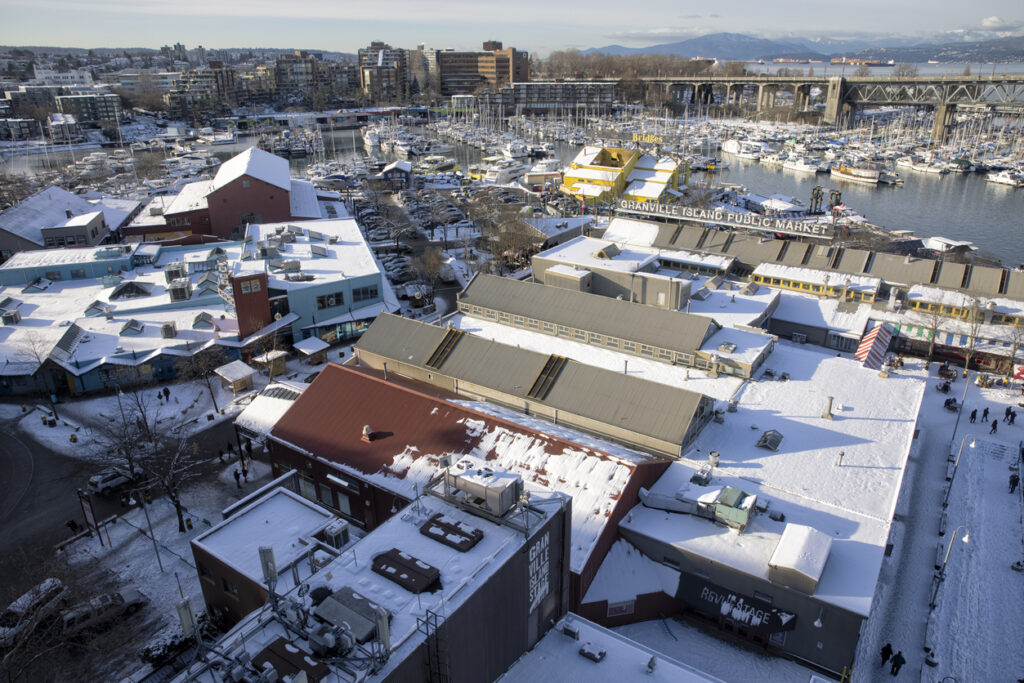As winter descends, commercial roofs face a unique set of challenges. The cold weather, snow, and ice can exacerbate existing issues and introduce new ones. To navigate these challenges effectively, roofers turn to advanced technologies like infrared imaging. In this blog, we’ll delve into the specific ways in which infrared imaging enhances winter roof inspections, uncovering hidden problems and ensuring the longevity of roofing systems.
Unveiling the Cold Weather Threats
As winter settles in, commercial roofs contend with an assortment of cold weather threats that demand careful inspection. Accumulating snow loads pose a risk, exerting substantial pressure on the roof’s structure and potentially compromising its integrity. Ice dams, a common winter woe, can form along roof edges, leading to water infiltration and leaks. Fluctuating temperatures exacerbate challenges by impacting the efficiency of insulation. These threats are often insidious, concealing themselves beneath the surface and eluding traditional visual inspections. The significance of a comprehensive winter roof inspection becomes evident in identifying and mitigating these risks promptly. This is where advanced technologies like infrared imaging prove invaluable, providing a nuanced understanding of potential vulnerabilities and empowering proactive measures to fortify commercial roofs against the adversities of the season.
The Role of Infrared Imaging in Winter Roof Inspections
Infrared imaging, also known as thermography, plays a pivotal role in winter roof inspections, offering a non-invasive and highly effective method to identify potential issues. This technology operates within the infrared spectrum of light, which is invisible to the human eye. In the winter months, when roofs are subjected to harsh conditions, the capabilities of infrared imaging become invaluable.
How Infrared Imaging Works
Infrared imaging operates on the principle of detecting thermal energy emitted from objects. Equipped with specialized sensors, infrared cameras capture the varying levels of infrared radiation an object emits. The intensity of this radiation correlates with the object’s temperature, with warmer objects emitting more intense infrared radiation than cooler ones. The camera translates these thermal variations into a visible image, vividly displaying temperature differences across the surface of the roof. This capability enables roofers to identify thermal contrasts, making infrared imaging a potent diagnostic tool. By visualizing these differences, infrared imaging enhances the precision of winter roof inspections, allowing for the early identification of insulation issues, leaks, and potential moisture-related problems.
Identifying Insulation Issues
In winter, the effectiveness of a roof’s insulation is paramount for sustaining energy efficiency and averting heat loss. Inadequate insulation not only results in heightened energy costs but also contributes to discomfort within indoor spaces. Here, infrared imaging proves highly beneficial, showcasing its proficiency in accentuating thermal variations. This capability makes it exceptionally effective in identifying regions with insufficient insulation. By precisely pinpointing these areas, roofers can strategize and implement targeted improvements. The result is an enhanced insulation setup, ensuring not only energy efficiency but also a more comfortable and cost-effective indoor environment. In the realm of winter roof inspections, infrared imaging emerges as a vital tool for optimizing insulation performance and overall building comfort.
Detecting Leaks and Moisture Intrusion
As winter unfolds, the heightened risk of leaks and moisture intrusion poses a considerable threat to commercial roofs, especially in the presence of accumulating snow and ice. In this context, infrared imaging emerges as a highly effective solution for detecting subtle temperature differences that often signal potential moisture-related issues. The technology allows roofers to peer into the thermal intricacies of the roof, unveiling hidden pockets of moisture. This capability offers a comprehensive understanding of the extent of the problem, enabling early intervention and preventing extensive damage. In the winter landscape where the stakes for roof integrity are high, the ability of infrared imaging to pinpoint potential leaks with precision becomes a crucial asset. It not only safeguards against significant structural damage but also serves as a proactive measure for long-term cost savings and the preservation of the roof’s lifespan.
Advantages of Infrared Imaging in Winter
Winter brings unique challenges to commercial roofs, and incorporating advanced technologies into inspections becomes crucial. In this context, infrared imaging emerges as a powerful tool. CORE Forensics leverages this technology, aligning with A2LA guidelines, to enhance winter roof inspections. Here are key advantages of integrating infrared imaging into your winter maintenance strategy:
- Non-invasive and Non-destructive
Unlike traditional inspection methods that may involve physical probing or material removal, infrared imaging is non-invasive. It preserves the integrity of roofing materials, ensuring that the inspection process itself doesn’t contribute to potential damage.
- Cost-effectiveness
Early detection of issues through infrared imaging prevents minor problems from evolving into major, costly repairs. This proactive approach can lead to significant savings for property owners in the long run.
- Efficiency
Infrared inspections provide comprehensive and accurate assessments without disrupting daily operations. Traditional inspections can be time-consuming and often necessitate extensive preparations. Infrared imaging offers a swift and efficient alternative, allowing inspections to be carried out seamlessly.
- Precision Aligned with Guidelines
The technology used by CORE Forensics for infrared imaging is aligned with A2LA guidelines, ensuring that the results are precise and reliable. This commitment to accuracy makes infrared inspections a trustworthy method for assessing the condition of commercial roofs.
How CORE Forensics Elevates Winter Roof Inspections
CORE Forensics, with its cutting-edge technology and a team of skilled experts, takes winter roof inspections to the next level. The company is committed to using top-notch equipment and materials in its certified lab, ensuring that testing results are accurate, reliable, and trustworthy. The fast and efficient service provided by CORE Forensics delivers timely results without compromising quality. The precision of results, aligned with A2LA guidelines, showcases CORE Forensics as a trustworthy partner for precise forensic testing.
Embracing Winter with Confidence
As winter poses unique challenges to commercial roofs, the integration of infrared imaging becomes a strategic choice for proactive inspections. The ability to identify insulation issues, detect leaks, and prevent potential problems sets the stage for a resilient roofing system. CORE Forensics, with its dedication to excellence and advanced testing methodologies, stands ready to elevate winter roof inspections. Embrace the winter season with confidence, knowing that infrared imaging and the expertise of CORE Forensics are safeguarding your commercial investment.

